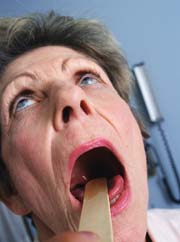Constant dryness in the mouth, what is the solution?

Goujerot-Sjögren syndrome mostly affects elderly women
Dryness in the mouth is not an agreeable sensation and much less so if the condition becomes an illness. Effectively, there are illnesses related to lack of saliva, as is the case of the sicca-sicca disease and the Goujerot-Sjögren syndrome.
The research regarding these uncommon illnesses began to be important in 1976 when new functions of the molecule ATP (adenine triphosphate) were discovered. In that year it was found that the ATP molecule and its derivative controlled a number of biological processes and, based on those results, research began on the relation between ATP and the secretion of saliva.
This research had both biological and medical interest, for example, in order to cure the above-mentioned ailments.
The sicca-sicca disease and the Goujerot-Sjögren syndrome are normally associated with the elderly and result in both a lack of saliva and a lack of tears. The lack of saliva produces dryness of the mouth, difficulty in speaking and eating and, in the case of lack of tears, the patient may even become blind.
The importance of saliva
Saliva cleans and protects the mouth, the digestive tract and the stomach. It contains the proteases and other enzymes such as EFG (Epidermal Growth Factor). These enzymes help skin growth, thus curing the small wounds that food produces in both the digestive tract and the mouth.
Taking into account the importance of saliva, the research team at Leioa (University of the Basque Country) studied in principle the salivary glands, for example the gland located below the mandible. These glands, when the Goujerot-Sjögren syndrome is present, secrete a protein. These proteins, at the same time, produce an increase in the number of T-lymphocytes around the gland and this is soon completely surrounded by proteins and antibodies. The gland cannot produce saliva in this situation and so, little by little, it self-destructs; i.e., the Goujerot-Sjögren syndrome is an auto-immune illness.
It was precisely during these studies where it was seen that the ATP molecule and its receptors, the purinergic receptors, played an important role in the secretion of saliva. More specifically, it was seen that the ATP is generated on eating or at the beginning of digestion; i.e., when the salivary glands are excited.
The following step in the research was to characterise the ATP receptors and analyse the process followed by the chemical signals in the cells. In this way they discovered that, in illnesses associated with lack of saliva, the ATP was capable of opening the ducts which secrete the fluid. The same happens with the eye when tears are lacking, or in the trachea when fluids for cleaning it are lacking, and also with patients who have their bronchial tubes obstructed or in cystic fibrosis. Likewise, ATP has a positive effect on the blood platelets, thus avoiding possible thrombosis.
Thus, ATP and its derivatives promote the secretion of fluids and is a new field for medication for these illnesses. The newly-discovered functions of a little-studied molecule could be the solution for many patients.
Contact :
Garazi Andonegi
ELHUYAR Fundazioa
garazi@elhuyar.com
(+34) 943363040
Media Contact
More Information:
http://www.basqueresearch.comAll latest news from the category: Health and Medicine
This subject area encompasses research and studies in the field of human medicine.
Among the wide-ranging list of topics covered here are anesthesiology, anatomy, surgery, human genetics, hygiene and environmental medicine, internal medicine, neurology, pharmacology, physiology, urology and dental medicine.
Newest articles

Silicon Carbide Innovation Alliance to drive industrial-scale semiconductor work
Known for its ability to withstand extreme environments and high voltages, silicon carbide (SiC) is a semiconducting material made up of silicon and carbon atoms arranged into crystals that is…

New SPECT/CT technique shows impressive biomarker identification
…offers increased access for prostate cancer patients. A novel SPECT/CT acquisition method can accurately detect radiopharmaceutical biodistribution in a convenient manner for prostate cancer patients, opening the door for more…

How 3D printers can give robots a soft touch
Soft skin coverings and touch sensors have emerged as a promising feature for robots that are both safer and more intuitive for human interaction, but they are expensive and difficult…





















